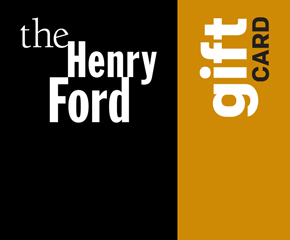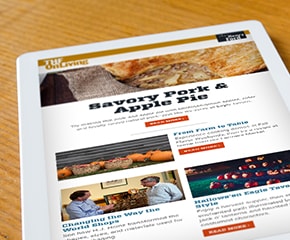What If
Abraham Lincoln’s experiences on the Judicial Circuit helped him hone skills and establish relationships that prepared him to become President of the United States. Lincoln as lawyer provided the foundation of support upon which Lincoln as politician was constructed. Guy C. Fraker, author of "Lincoln’s Ladder to the Presidency: The Eighth Judicial Circuit”
Abraham Lincoln woke up that bright Spring morning with a smile on his face and a sense of anticipation. He quickly got ready for the day, then checked what he had packed the night before: some changes of clothes, a large leather portfolio filled with legal papers, a few favored books, and a folding shaving mirror because he felt that being clean-shaven set a good impression. He donned his tall, felt stovepipe hat, wrapped a shawl around his shoulders to keep out the morning chill, saddled up his horse Old Bob, and was off for an eagerly awaited three-month journey on the Judicial Circuit.

Every Spring and Fall, Lincoln traveled with a judge and a group of lawyers like himself to the small towns and villages of the Eighth Judicial Circuit. He loved the life of a traveling circuit lawyer. He could put his legal expertise to use, hone his skills of quick thinking and persuasion, catch up with old friends, and enjoy some much-needed solitude. He didn’t know it yet but this experience would prepare him to later serve as President of the United States.
Passion for the Law
As a young man, Lincoln was intrigued by the law. He liked the idea of living by his wits, being respected by the local community, and rising up in the world. He hung around frontier courthouses, watching lawyers examine witnesses and deliver impassioned speeches. He also sat on juries, occasionally appeared as a witness, and even drew up legal documents for neighbors. When Lincoln was only 25, John T. Stuart, a Springfield, Illinois, lawyer, urged him to study law and granted him access to his law library. From these and other books, Lincoln learned and memorized legal codes and precedents. After three years of study on his own, he passed his exams. He was granted a license to practice law on March 24, 1837.
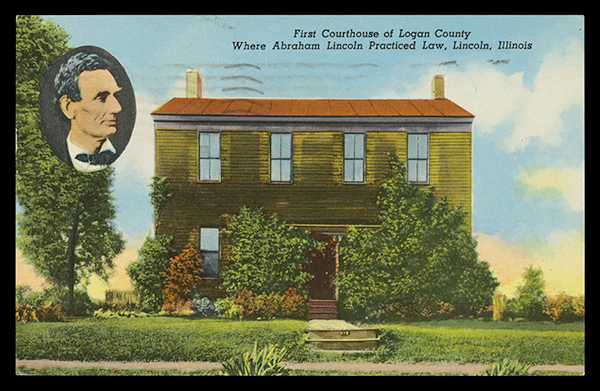
During the 1840s and 1850s, Lincoln became known as one of the outstanding lawyers in Illinois. He practiced law before the Illinois Supreme Court and in the U.S. Circuit and District courts, all of which met in the state capital of Springfield. He handled many important cases and his name as counsel carried prestige in a lawsuit. His record in the Supreme Court of Illinois was considered outstanding.
While his primary law practice was in Springfield, economic necessity forced Lincoln (like other Springfield lawyers) to try cases in county courthouses out in the surrounding countryside, together constituting what was known as the Eighth Judicial Circuit. Except for two years when he served in the U.S. Congress, Lincoln traveled this Circuit from the time it was created in 1839 until he was elected President in 1860. Lincoln’s legal training and experience helped him deal with complicated issues when he became President, such as the Southern states’ secession from the Union and the writing of the Emancipation Proclamation.
Honing Skills
"Hon. Abraham Lincoln, Our Next President," 1860
Artifact
Print (Visual work)
Date Made
1860
Summary
This lithograph portrait of President-elect Abraham Lincoln was based on a photograph taken by Mathew B. Brady on February 27, 1860. Lincoln had been in New York City to give a speech at Cooper Union. He is depicted beardless as he was during the election campaign. By the time he traveled to Washington, D.C., for his inauguration on March 4, 1861, he had grown a full beard.
Creators
Place of Creation
Keywords
Object ID
00.3.11285
Credit
From the Collections of The Henry Ford.
Location
Not on exhibit to the public.
Get more details in Digital Collections at:
"Hon. Abraham Lincoln, Our Next President," 1860
What is The Henry Ford?
The national attraction for discovering your ingenuity while exploring America’s spirit of innovation. There is always much to see and do at The Henry Ford.
Once court was in session, judges and lawyers quickly got down to business. They met with local lawyers and clients, then prepared cases using available information. The rushed nature of court proceedings, the limited opportunity to prepare, and the wide range of subject matter and people forced them to be quick-thinking, sharp-witted, and flexible under fire—traits in which Abraham Lincoln excelled.
Lincoln thrived as a lawyer on the Judicial Circuit, handling all kinds of cases and representing different types of people. He developed an extraordinary ability to listen, understand, and represent opposing viewpoints and he became highly respected and trusted by clients, lawyers, and judges. The skills and talents that Lincoln honed during his experiences as a lawyer traveling on the Circuit later helped him in his bid for, and challenges as, U.S. President. These included:
- • Adaptability – absorbing a wide range of information, opinions, and advice with minimal time to digest, then responding quickly and appropriately
- • Persuasion – convincing witnesses to disclose the whole truth, then persuading the jury toward his point of view using compelling arguments
- • Lack of egotism – logically and concisely stating the facts in a case
- • Storytelling and humor – possessing a seemingly inexhaustible supply of stories and anecdotes, drawn from his own experience and those of others, then laughing along with everyone else at these stories
- • Empathy – listening to and understanding opposing viewpoints without rancor, along with a sensitivity to the attitudes and motives of clients, witnesses, and judges
- • Integrity – believing in absolute honesty
- • Perception – understanding the subtle art of mediation, especially because the individuals in a case often knew each other in the close-knit communities in which he practiced law on the Circuit
Building Networks
Zachary Taylor Campaign Buttons, 1848
Artifact
Stud (Button)
Date Made
1848
Summary
Zachary Taylor served in the military most of his life and earned the nickname "Old Rough and Ready" from his men for his willingness to share in the hardships of field duty. The moniker became widespread after his victories during the Mexican-America War. In 1848, when Taylor ran for President, backers donned buttons such as these to show their support.
Place of Creation
Keywords
Object ID
30.557.41
Credit
From the Collections of The Henry Ford.
Location
Not on exhibit to the public.
Get more details in Digital Collections at:
Zachary Taylor Campaign Buttons, 1848
What is The Henry Ford?
The national attraction for discovering your ingenuity while exploring America’s spirit of innovation. There is always much to see and do at The Henry Ford.
Lincoln used his time in the towns and village of the Eighth Judicial Circuit to get to know the local people, staying in their homes, participating in their entertainments and athletic contests, engaging in debates, playing cards, holding conversations, and telling stories. He also befriended newspaper editors and local politicians when he arrived in various towns. All these personal relationships would provide crucial support and political backing during Lincoln’s run for the Presidency.
Lincoln also used the skills of rhetoric and persuasion he honed on the Circuit to give speeches endorsing three Whig Presidential candidates during this time: William Henry Harrison in 1840, Henry Clay in 1844, and Zachary Taylor in 1848. The Whig platform of the 1840s would form the foundation of the Republican Party that later nominated Lincoln for President.
When Lincoln returned to Springfield in 1849, after serving two years in the U.S. Congress, he rejoined the traveling Circuit. During this time, he grew close to Judge David Davis, who later spearheaded his Presidential campaign. He also established and reconfirmed other relationships that proved important to his future reentry into politics.
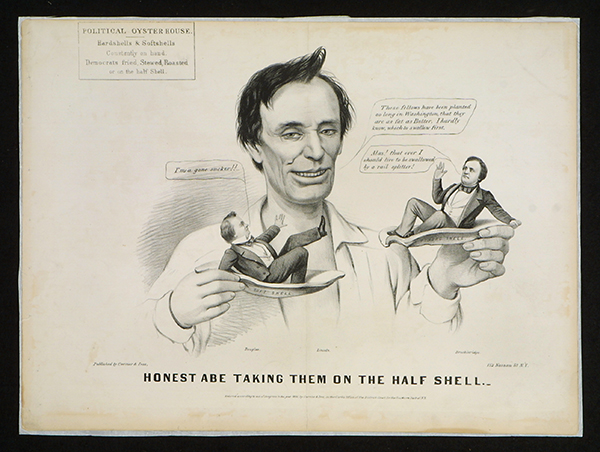
Not all of Lincoln’s acquaintances were friends and supporters. Among his political rivals was Democrat Stephen A. Douglas, another Springfield lawyer who defeated him in the 1858 race for the U.S. Senate. Although Douglas won the election, the searing debates between the two men created so much publicity that they elevated Lincoln’s stature to a national level and ultimately helped people recognize his name in the upcoming Presidential campaign.
When it came time for the newly formed Republican Party to get behind a presidential candidate for the 1860 election, Lincoln’s network of Judicial Circuit friends and acquaintances worked tirelessly to get him nominated and then elected.
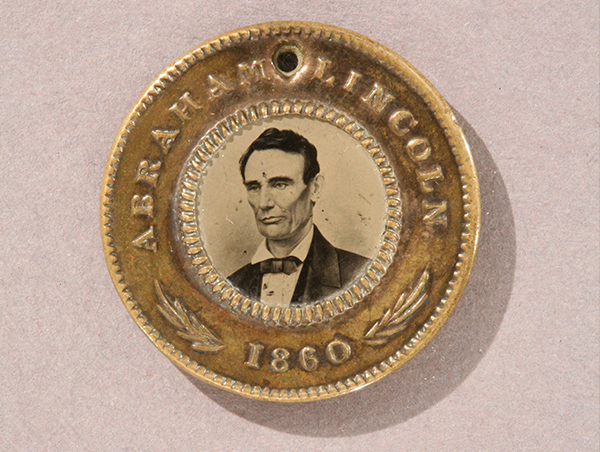
From Man to Legend
As memories of the real Abraham Lincoln faded over time, the legendary stories of his character—honed during his years on the 8th Judicial Circuit—persisted. A new generation of Americans transformed Lincoln from man to a legend.
On February 12, 1909, virtually the entire nation honored Abraham Lincoln on the 100th anniversary of his birth. In city after city, Americans put aside their regional differences and sought national unity by venerating Lincoln as a “man of the people.”
Postcard Commemorating the Centennial of Abraham Lincoln's Birth, 1909
Artifact
Postcard
Date Made
1909
Summary
On February 12, 1909, virtually the entire nation turned out to honor Abraham Lincoln on the 100th anniversary of his birth. In city after city, Americans put aside their regional differences and sought national unity by venerating Lincoln as a "man of the people." Postcards abounded as popular keepsakes, including this German-imported embossed example.
Place of Creation
Keywords
Object ID
66.143.844
Credit
From the Collections of The Henry Ford.
Location
By Request in the Benson Ford Research Center
Get more details in Digital Collections at:
Postcard Commemorating the Centennial of Abraham Lincoln's Birth, 1909
What is The Henry Ford?
The national attraction for discovering your ingenuity while exploring America’s spirit of innovation. There is always much to see and do at The Henry Ford.
During the First World War, Lincoln’s reputation extended beyond American shores to the international arena. Although his tactics as Commander-in-Chief during the Civil War had been questioned during his own time, his legendary character traits now seemed to exemplify visionary leadership.
Born two years before Lincoln was assassinated, Henry Ford had grown up surrounded by Lincoln myths and stories. As Ford became an enterprising automobile entrepreneur, Lincoln’s lessons were not lost on him. To Ford, Lincoln embodied the ideals of the “self-made man,” rising up from humble beginnings to make something of himself.
Logan County Courthouse
Artifact
Courthouse
Date Made
1840
Summary
Between 1840 and 1847, Abraham Lincoln tried cases here as a traveling lawyer. Visiting once or twice a year, he worked mostly on cases resolving neighbors' disagreements over land, contracts, and debts. As Lincoln traveled, people got to know him because he always took time to talk to them. This helped him earn votes later when he went into politics.
Place of Creation
Object ID
29.3046.1
Credit
From the Collections of The Henry Ford.
Get more details in Digital Collections at:
Logan County Courthouse
What is The Henry Ford?
The national attraction for discovering your ingenuity while exploring America’s spirit of innovation. There is always much to see and do at The Henry Ford.
By the 1920s, Henry Ford began to amass a collection to honor his hero—including the rocker that Lincoln had been sitting in at Ford’s Theatre the night he was assassinated. When Ford heard of a neglected Illinois courthouse in which Lincoln had practiced law on the Eighth Judicial Circuit, Ford knew that this was the key for which he had been searching. This courthouse, reconstructed in Greenfield Village in 1929, housed Henry Ford’s Lincoln collection. Ford wanted to use the building and the display inside it to teach young people about “the application of the practical principles of justice and common sense so often exemplified by Abraham Lincoln in everyday life.” Indeed, this seems a fitting commemoration to the President who started his career as a traveling circuit lawyer.
Donna Braden is Curator of Public Life at The Henry Ford.
I would hope that we would remember him even more for the man he was, even greater than the president he was or the political figure he was. Because, he was an extraordinary man. And, when you learn about his character, that’s relevant for all of us in our lives. Not just our political lives.Doris Kearns Goodwin Biographer, historian and political commentator
Browse Collections
Portrait of Abraham Lincoln, Springfield, Illinois, 1846-1847
Artifact
Photographic print
Summary
Nicholas H. Shepherd made the original daguerreotype for this image in Springfield, Illinois, shortly after Lincoln's election to Congress in 1846. It is believed by many to be the earliest known image of Lincoln, who was 37 or 38 years old. At this time, Lincoln was a husband and father of two small boys and operated a successful law practice in Springfield.
Creators
Place of Creation
Object ID
00.1334.112
Credit
From the Collections of The Henry Ford. Gift of Ford Motor Company.
Location
By Request in the Benson Ford Research Center
Get more details in Digital Collections at:
Portrait of Abraham Lincoln, Springfield, Illinois, 1846-1847
What is The Henry Ford?
The national attraction for discovering your ingenuity while exploring America’s spirit of innovation. There is always much to see and do at The Henry Ford.


"First Court House of Logan County Where Abraham Lincoln Practiced Law, Lincoln, Ill.," 1927 Postcard
 Details
Details
"First Court House of Logan County Where Abraham Lincoln Practiced Law, Lincoln, Ill.," 1927 Postcard
Artifact
Postcard
Date Made
1927
Summary
Between 1840 and 1847, Abraham Lincoln tried cases as a traveling lawyer in this courthouse when it was located in Postville (later Lincoln), Illinois. When the Logan County seat moved to Mt. Pulaski, this courthouse was reused as a general store, jail, post office, and private dwelling. Henry Ford purchased it in 1929 and brought it to Greenfield Village.
Creators
Place of Creation
Object ID
89.0.543.275
Credit
From the Collections of The Henry Ford.
Location
By Request in the Benson Ford Research Center
Get more details in Digital Collections at:
"First Court House of Logan County Where Abraham Lincoln Practiced Law, Lincoln, Ill.," 1927 Postcard
What is The Henry Ford?
The national attraction for discovering your ingenuity while exploring America’s spirit of innovation. There is always much to see and do at The Henry Ford.


"The Old Log Court House Where Abraham Lincoln Practiced Law," Decatur, Illinois, 1943 Postcard
 Details
Details
"The Old Log Court House Where Abraham Lincoln Practiced Law," Decatur, Illinois, 1943 Postcard
Artifact
Postcard
Date Made
1943
Summary
By the early 20th century, the real Abraham Lincoln had long since faded from people's memory. A new generation of Americans had come of age who only knew the stories, the myths, the legends. This generation transformed Lincoln the man into Lincoln the hero. Local residents of Decatur, Illinois, saved and preserved their old log courthouse where Lincoln once practiced law.
Creators
Object ID
66.143.835
Credit
From the Collections of The Henry Ford.
Location
By Request in the Benson Ford Research Center
Get more details in Digital Collections at:
"The Old Log Court House Where Abraham Lincoln Practiced Law," Decatur, Illinois, 1943 Postcard
What is The Henry Ford?
The national attraction for discovering your ingenuity while exploring America’s spirit of innovation. There is always much to see and do at The Henry Ford.

Lithograph, "Mr. Lincoln, Residence and Horse as They Appeared on His Return from the Campaign with Senator Douglas," 1858
 Details
Details
Lithograph, "Mr. Lincoln, Residence and Horse as They Appeared on His Return from the Campaign with Senator Douglas," 1858
Artifact
Print (Visual work)
Date Made
1865
Summary
Abraham and Mary Lincoln purchased a small home in Springfield, Illinois in 1844, shortly after their marriage. In 1856, with a growing family and income, they enlarged the house, seen here. After the 1860 election, they sold most of their furnishings and rented the house. This print, published in 1865 is likely a memorial - it shows a bearded Lincoln, though he did not have one in 1858.
Place of Creation
Object ID
89.0.332.236
Credit
From the Collections of The Henry Ford.
On Exhibit
Not on exhibit to the public.
Get more details in Digital Collections at:
Lithograph, "Mr. Lincoln, Residence and Horse as They Appeared on His Return from the Campaign with Senator Douglas," 1858
What is The Henry Ford?
The national attraction for discovering your ingenuity while exploring America’s spirit of innovation. There is always much to see and do at The Henry Ford.
Logan County Courthouse
Artifact
Courthouse
Date Made
1840
Summary
Between 1840 and 1847, Abraham Lincoln tried cases here as a traveling lawyer. Visiting once or twice a year, he worked mostly on cases resolving neighbors' disagreements over land, contracts, and debts. As Lincoln traveled, people got to know him because he always took time to talk to them. This helped him earn votes later when he went into politics.
Place of Creation
Object ID
29.3046.1
Credit
From the Collections of The Henry Ford.
Get more details in Digital Collections at:
Logan County Courthouse
What is The Henry Ford?
The national attraction for discovering your ingenuity while exploring America’s spirit of innovation. There is always much to see and do at The Henry Ford.
"The National Whig Song," 1840
Artifact
Sheet music
Date Made
1840
Summary
Political parties use campaign songs to literally sing the praises of their candidates. In 1840, songwriters wrote dozens upon dozens of lyrics for the presidential nominees. The National Whig Song, performed at campaign rallies, parades and barbeques, lauded the life of William Henry Harrison. Voters voiced their approval for the "fine, true-hearted gentleman" and made Harrison the next U.S. President.
Place of Creation
Keywords
Object ID
72.97.2
Credit
From the Collections of The Henry Ford.
Location
By Request in the Benson Ford Research Center
Get more details in Digital Collections at:
"The National Whig Song," 1840
What is The Henry Ford?
The national attraction for discovering your ingenuity while exploring America’s spirit of innovation. There is always much to see and do at The Henry Ford.
Zachary Taylor Campaign Buttons, 1848
Artifact
Stud (Button)
Date Made
1848
Summary
Zachary Taylor served in the military most of his life and earned the nickname "Old Rough and Ready" from his men for his willingness to share in the hardships of field duty. The moniker became widespread after his victories during the Mexican-America War. In 1848, when Taylor ran for President, backers donned buttons such as these to show their support.
Place of Creation
Keywords
Object ID
30.557.41
Credit
From the Collections of The Henry Ford.
Location
Not on exhibit to the public.
Get more details in Digital Collections at:
Zachary Taylor Campaign Buttons, 1848
What is The Henry Ford?
The national attraction for discovering your ingenuity while exploring America’s spirit of innovation. There is always much to see and do at The Henry Ford.
Political Cartoon, "Honest Abe Taking Them on the Half Shell," 1860
Artifact
Print (Visual work)
Date Made
1860
Summary
This political cartoon for the 1860 presidential campaign depicts Abraham Lincoln, the fledgling Republican Party presidential candidate, handily taking on rival candidates while eating at the "Political Oyster House." He was facing three other presidential hopefuls. Northern Democrats turned to Stephen Douglas of Illinois, while southern Democrats selected John C. Breckenridge of Kentucky. In addition, John Bell of Tennessee was a third-party choice.
Creators
Place of Creation
Keywords
Douglas, Stephen A. (Stephen Arnold), 1813-1861
Object ID
26.93.38
Credit
From the Collections of The Henry Ford.
On Exhibit
Not on exhibit to the public.
Get more details in Digital Collections at:
Political Cartoon, "Honest Abe Taking Them on the Half Shell," 1860
What is The Henry Ford?
The national attraction for discovering your ingenuity while exploring America’s spirit of innovation. There is always much to see and do at The Henry Ford.
"Hon. Abraham Lincoln, Our Next President," 1860
Artifact
Print (Visual work)
Date Made
1860
Summary
This lithograph portrait of President-elect Abraham Lincoln was based on a photograph taken by Mathew B. Brady on February 27, 1860. Lincoln had been in New York City to give a speech at Cooper Union. He is depicted beardless as he was during the election campaign. By the time he traveled to Washington, D.C., for his inauguration on March 4, 1861, he had grown a full beard.
Creators
Place of Creation
Keywords
Object ID
00.3.11285
Credit
From the Collections of The Henry Ford.
Location
Not on exhibit to the public.
Get more details in Digital Collections at:
"Hon. Abraham Lincoln, Our Next President," 1860
What is The Henry Ford?
The national attraction for discovering your ingenuity while exploring America’s spirit of innovation. There is always much to see and do at The Henry Ford.
Abraham Lincoln and Hannibal Hamlin Campaign Button, 1860
Artifact
Button (Information artifact)
Date Made
1860
Summary
Abraham Lincoln and Hannibal Hamlin campaign button for the 1860 presidential election containing tintype portraits of the Republican Party candidates on each side. This use of photography in political campaigns was still unusual at the time--most campaign buttons did not include photographic images of the candidates.
Place of Creation
Keywords
Object ID
72.31.396
Credit
From the Collections of The Henry Ford.
Location
Not on exhibit to the public.
Get more details in Digital Collections at:
Abraham Lincoln and Hannibal Hamlin Campaign Button, 1860
What is The Henry Ford?
The national attraction for discovering your ingenuity while exploring America’s spirit of innovation. There is always much to see and do at The Henry Ford.
Postcard Commemorating the Centennial of Abraham Lincoln's Birth, 1909
Artifact
Postcard
Date Made
1909
Summary
On February 12, 1909, virtually the entire nation turned out to honor Abraham Lincoln on the 100th anniversary of his birth. In city after city, Americans put aside their regional differences and sought national unity by venerating Lincoln as a "man of the people." Postcards abounded as popular keepsakes, including this German-imported embossed example.
Place of Creation
Keywords
Object ID
66.143.844
Credit
From the Collections of The Henry Ford.
Location
By Request in the Benson Ford Research Center
Get more details in Digital Collections at:
Postcard Commemorating the Centennial of Abraham Lincoln's Birth, 1909
What is The Henry Ford?
The national attraction for discovering your ingenuity while exploring America’s spirit of innovation. There is always much to see and do at The Henry Ford.
Interior of Logan County Courthouse in Greenfield Village, April 1954
Artifact
Photographic print
Summary
Henry Ford admired Lincoln's character and his embodiment of the ideals of the "self-made man." Ford collected many Lincoln-related artifacts, including the Logan County, Illinois, courthouse in which Lincoln had practiced law in the 1840s. This photograph, taken in the 1930s, shows how Mr. Ford displayed furniture from the Lincolns' Springfield home, acquired to honor Lincoln and provide visitors with a sense of the time period.
Keywords
United States, Michigan, Dearborn
Relocated buildings and structures
Object ID
EI.1929.879
Credit
From the Collections of The Henry Ford.
On Exhibit
Not on exhibit to the public.
Related Objects
Get more details in Digital Collections at:
Interior of Logan County Courthouse in Greenfield Village, April 1954
What is The Henry Ford?
The national attraction for discovering your ingenuity while exploring America’s spirit of innovation. There is always much to see and do at The Henry Ford.
Will Rogers, Charles Roscoe Miles, and Henry Ford in Greenfield Village, October 1934
Artifact
Photographic print
Summary
Henry Ford admired Lincoln's character and collected many Lincoln-related artifacts, including the Logan County, Illinois, courthouse in which Lincoln had practiced law in the 1840s. Here, Mr. Ford and Will Rogers stands outside the courthouse with Lincoln portrayer Charles Roscoe Miles. Miles was a distant relative of Lincoln's and used his resemblance to the president to support himself during the Great Depression.
Place of Creation
Keywords
United States, Michigan, Dearborn
Relocated buildings and structures
Miles, Charles Roscoe, b. 1871
Object ID
P.833.101592.24
Credit
From the Collections of The Henry Ford. Gift of Ford Motor Company.
Location
By Request in the Benson Ford Research Center
Related Objects
Get more details in Digital Collections at:
Will Rogers, Charles Roscoe Miles, and Henry Ford in Greenfield Village, October 1934
What is The Henry Ford?
The national attraction for discovering your ingenuity while exploring America’s spirit of innovation. There is always much to see and do at The Henry Ford.
Logan County Courthouse Being Reconstructed in Greenfield Village, October 2, 1929
Artifact
Photographic print
Summary
Henry Ford admired President Lincoln's humble, down-to-earth character and his embodiment of the ideals of the "self-made man." Ford collected many Lincoln-related artifacts, including the Logan County, Illinois, courthouse in which Lincoln had practiced law in the 1840s. Despite perturbed townspeople, Ford workers quickly dismantled, moved, and re-erected the building for the opening of Greenfield Village on October 21, 1929.
Object ID
P.O.5852
Credit
From the Collections of The Henry Ford. Gift of Ford Motor Company.
On Exhibit
Not on exhibit to the public.
Related Objects
Get more details in Digital Collections at:
Logan County Courthouse Being Reconstructed in Greenfield Village, October 2, 1929
What is The Henry Ford?
The national attraction for discovering your ingenuity while exploring America’s spirit of innovation. There is always much to see and do at The Henry Ford.
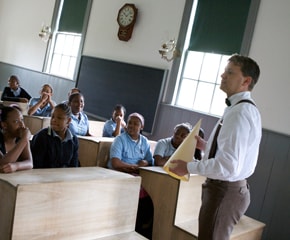
Discussion Questions
- What leadership traits did Abraham Lincoln illustrate as a lawyer?
- Which of these traits do you think was most important in helping him overcome obstacles?
- How did the traits Abraham Lincoln developed as a lawyer help him become president?
- What are some of the problems of today, and what leadership traits could you apply to solve them?
- Do you think you could lead like Abraham Lincoln? Why or why not?
Fuel Your Enthusiasm
The Henry Ford aims to provide unique educational experiences based on authentic artifacts, stories and lives from America’s tradition of ingenuity, resourcefulness, and innovation. Connect to more great educational resources:












